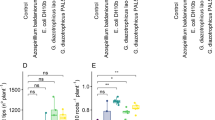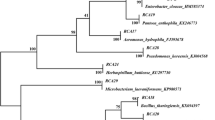Abstract
The exopolysaccharide (EPS) is an extracellular molecule that in Bradyrhizobium japonicum affects bacterial efficiency to nodulate soybean. Culture conditions such as N availability, type of C-source, or culture age can modify the amount and composition of EPS. To better understand the relationship among these conditions for EPS production, we analyzed their influence on EPS in B. japonicum USDA 110 and its derived mutant ΔP22. This mutant has a deletion including the 3′ region of exoP, exoT, and the 5′ region of exoB, and produces a shorter EPS devoid of galactose. The studies were carried out in minimal media with the N-source at starving or sufficient levels, and mannitol or malate as the only C-source. Under N-starvation there was a net EPS accumulation, the levels being similar in the wild type and the mutant with malate as the C-source. By contrast, the amount of EPS diminished in N-sufficient conditions, being poyhydroxybutyrate accumulated with culture age. Hexoses composition was the same in both N-situations, either with mannitol or malate as the only C-source, in contrast to previous observations made with different strains. This result suggests that the change in EPS composition in response to the environment is not general in B. japonicum. The wild type EPS composition was 1 glucose:0.5 galactose:0.5 galacturonic acid:0.17 mannose. In ΔP22 the EPS had no galactose but had galacturonic acid, thus indicating that it was not produced from oxidation of UDP-galactose. Infectivity was lower in ΔP22 than in USDA 110. When the mutant infectivity was compared between N-starved or N-sufficient cultures, the N-starved were not less infective, despite the fact that the amounts of altered EPS produced by this mutant under N-starvation were higher than in N-sufficiency. Since this altered EPS does not bind soybean lectin, the interaction of EPS with this protein was not involved in increasing ΔP22 infectivity under N-starvation.


Similar content being viewed by others
Abbreviations
- CPS:
-
Capsular polysaccharide
- DAI:
-
Days after inoculation
- EPS:
-
Exopolysaccharide
- Gal:
-
Galactose
- GalA:
-
Galacturonic acid
- Glc:
-
Glucose
- GlcA:
-
Glucuronic acid
- Mal:
-
Malate
- Man:
-
Mannose
- Mtl:
-
Mannitol
- PHB:
-
Polyhydroxybutyrate
- OD500 :
-
Optical density at 500 nm
- RDU:
-
Relative distance unit
- RT:
-
Root tip
- SBL:
-
Soybean lectin
- SERH:
-
Smallest emergent root hairs
References
Amarasingham CR, Davis BD (1965) Regulation of α-ketoglutarate dehydrogenase formation in Escherichia coli. J Biol Chem 240:3664–3668
An J, Carlson RW, Glushka J, Streeter JG (1995) The structure of a novel polysaccharide produced by Bradyrhizobium species within soybean nodules. Carbohydr Res 269:303–317
Becker BU, Kosch K, Parniske M, Müller P (1998) Exopolysaccharide (EPS) synthesis in Bradyrhizobium japonicum: sequence, operon structure and mutational analysis of an exo gene cluster. Mol Gen Genet 259:161–171
Bhuvaneswari TV, Turgeon BG, Bauer WD (1980) Early events in the infection of soybean (Glycine max L. Merr) by Rhizobium japonicum. I. Localization of infectible root cells. Plant Physiol 66:1027–1031
Bhuvaneswari BV, Mills KK, Crist DK, Evans WR, Bauer WD (1983) Effects of culture age on symbiotic infectivity of Rhizobium japonicum. J Bacteriol 153:443–451
Bradford MM (1976) A rapid and sensitive method for the quantitation of microgram quantities of protein utilizing the principle of protein-dye binding. Anal Biochem 72:248–254
Cevallos M, Encarnación S, Leija A, Mora Y, Mora J (1996) Genetic and physiological characterization of a Rhizobium etli mutant strain unable to synthesize poly-beta-hydroxybutyrate. J Bacteriol 178:1646–1654
Encarnación S, Dunn M, Willms K, Mora J (1995) Fermentative and aerobic metabolism in Rhizobium etli. J Bacteriol 177:3058–3066
Encarnación S, Vargas MC, Dunn MF, Dávalos A, Mendoza G, Mora Y, Mora J (2002) AniA regulates reserve polymer accumulation and global protein expression in Rhizobium etli. J Bacteriol 184:2287–2295
Fraysse N, Couderc F, Poinsot V (2003) Surface polysaccharide involvement in establishing the Rhizobium-legume symbiosis. Eur J Biochem 270:1365–1380
Gage DJ (2004) Infection and invasion of roots by symbiotic, nitrogen-fixing rhizobia during nodulation of temperate legumes. Microbiol Mol Biol Rev 68:280–300
González JE, Semino CE, Wang L-X, Castellano-Torres LE Walker GC (1998) Biosynthetic control of molecular weight in the polymerization of the octasaccharide subunits of succinoglycan, a symbiotically important exopolysaccharide of Rhizobium meliloti. Proc Natl Acad Sci USA 95:13477–13482
Götz R, Limmer N, Ober K, Schmitt R (1982) Motility and chemotaxis in two strains of Rhizobium with complex flagella. J Gen Microbiol 128:789–798
Hozbor DF, Pich Otero AJL, Lodeiro AR, Del Papa MF, Pistorio M, Lagares A (2004) Functional complementation among different surface polysaccharides in the symbiosis between Sinorhizobium meliloti and Medicago species. Res Microbiol 155:855–860
Kaneko T, Nakamura Y, Sato S et al (2002) Complete genomic sequence of nitrogen-fixing symbiotic bacterium Bradyrhizobium japonicum USDA 110. DNA Res 9:189–197
Karr DB, Liang R-T, Reuhs BL, Emerich DW (2000) Altered exopolysaccharides of Bradyrhizobium japonicum mutants correlate with impaired soybean lectin binding, but not with effective nodule formation. Planta 211:218–226
Kereszt A, Kiss E, Reuhs BL, Carlson RW, Kondorosi A, Putnoky P (1998) Novel rkp gene clusters of Sinorhizobium meliloti involved in capsular polysaccharide production and invasion of the symbiotic nodule: the rkpK gene encodes a UDP-glucose dehydrogenase. J Bacteriol 180:5426–5431
Laus MC, Logman TJ, Van Brussel AA, Carlson RW, Azadi P, Gao MY, Kijne JW (2004) Involvement of exo5 in production of surface polysaccharides in Rhizobium leguminosarum and its role in nodulation of Vicia sativa subsp. nigra. J Bacteriol 186:6617–6625
Law JH, Slepecky RA (1961) Assay of poly-hydroxybutyric acid. J Bacteriol 82:33–36
Lis H, Sela BA, Sachs L, Sharon N (1970) Specific inhibition by N-acetyl-d-galactosamine of the interaction between soybean agglutinin and animal cell surfaces. Biochim Biophys Acta 211:582–585
Lodeiro AR, González P, Hernández A, Balagué LJ, Favelukes G (2000) Comparison of drought tolerance in nitrogen-fixing and inorganic nitrogen-grown common beans. Plant Sci 154:31–41
López-García S, Vázquez TE E, Favelukes G, Lodeiro A (2001) Improved soybean root association of N-starved Bradyrhizobium japonicum. J Bacteriol 183:7241–7252
Louch HA, Miller KJ (2001) Synthesis of a low-molecular-weight form of exopolysaccharide by Bradyrhizobium japonicum USDA 110. Appl Environ Microbiol 67:1011–1014
Mort AJ, Bauer WD (1980) Composition of the capsular and extracellular polysaccharides of Rhizobium japonicum. Changes with culture age and correlations with binding of soybean seed lectin to the bacteria. Plant Physiol 66:158–163
Mort AJ, Bauer WD (1982) Application of two new methods for cleavage of polysaccharides into specific oligosaccharide fragments. Structure of the capsular and extracellular polysaccharides of Rhizobium japonicum that bind soybean lectin. J Biol Chem 257:1870–1875
Niehaus K, Baier R, Kohring B, Flashl E, Pühler A (1997) Symbiotic suppression of the Medicago sativa plant defence system by Rhizobium meliloti oligosaccharides. In: Legoki A, Bothe H, Pühler A (eds) Biological fixation of nitrogen for ecology and sustainable agriculture. Springer, Berlin Heidelberg New York, pp 110–114
Niemeyer D, Becker A (2001) The molecular weight distribution of succinoglycan produced by Sinorhizobium meliloti is influenced by specific tyrosine phosphorylation and ATPase activity of the cytoplasmic domain of the ExoP protein. J Bacteriol 183:5163–5170
Ong LC, Lin Y-H (2003) Metabolite profiles and growth characteristics of Rhizobium meliloti cultivated at different specific growth rates. Biotechnol Prog 19:714–719
Panzieri M, Marchettini N, Hallam TG (2000) Importance of the Bradyrhizobium japonicum symbiosis for the sustainability of a soybean cultivation. Ecol Model 135:301–310
Parniske M, Kosch K, Werner D, Müller P (1993) ExoB mutants of Bradyrhizobium japonicum with reduced competitiveness for nodulation of Glycine max. Mol Plant-Microbe Interact 6:99–106
Parniske M, Schmidt PE, Kosch K, Müller P (1994) Plant defense responses of host plants with determinate nodules induced by EPS-defective exoB mutants of Bradyrhizobium japonicum. Mol Plant-Microbe Interact 7:631–638
Patriarca EJ, Tatè R, Ferraioli S, Iaccarino M (2004) Organogenesis of the legume root nodules. Int Rev Cytol 234:201–262
Streeter JG, Salminen SO, Whitmoyer RE, Carlson RW (1992) Formation of novel polysaccharides by Bradyrhizobium japonicum bacteroids in soybean nodules. Appl Environ Microbiol 58:607–613
Trevelyan WE, Harrison JS (1952) Studies on yeast metabolism. I. Fractionation and microdetermination of cell carbohydrates. Biochem J 50:298–310
van Rhijn P, Goldberg RB, Hirsch AM (1998) Lotus corniculatus nodulation specificity is changed by the presence of a soybean lectin gene. Plant Cell 10:1233–1249
Vincent J M (1970) A manual for the practical study of the root nodule bacteria. IBP handbook No. 15. Blackwell, Oxford
Acknowledgments
This work was supported by International Foundation for Science (Sweden) grant No. C/2736-2 and Agencia Nacional de Promoción Científica y Tecnológica grant No. PICT 08-9809. JIQ and EJM are Doctoral fellows of CONICET; SLLG is a Postdoctoral fellow of CONICET; MJA and JPG are Doctoral fellows of ANPCyT; AC and ARL are members of the Scientific Career of CONICET, Argentina. The authors are grateful to A. McCarthy and N. Stern for English revision.
Author information
Authors and Affiliations
Corresponding author
Rights and permissions
About this article
Cite this article
Quelas, J.I., López-García, S.L., Casabuono, A. et al. Effects of N-starvation and C-source on Bradyrhizobium japonicum exopolysaccharide production and composition, and bacterial infectivity to soybean roots. Arch Microbiol 186, 119–128 (2006). https://doi.org/10.1007/s00203-006-0127-3
Received:
Revised:
Accepted:
Published:
Issue Date:
DOI: https://doi.org/10.1007/s00203-006-0127-3




